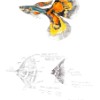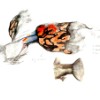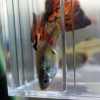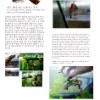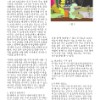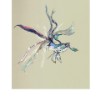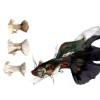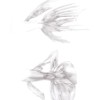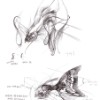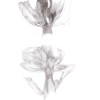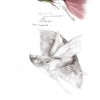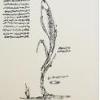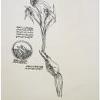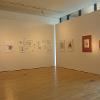
Installation details including Gold fish; Artist killed, ants carved him
Betafish, gold leaf

Detail of Rabbit town
moss terrarium, plant, porcelain animal figures, name tag

Since 2007, conveying meaning beyond object and text began to emerge as one of my major artistic interests. My methods have been various and have included painting, drawing, installation, text annotation, and even jewelry making. Using a wide breath of methods and materials has allowed me to play with my identity and position as an artist. I have pretended to be an excavator, an archeologist, and a recorder at the same time in a fictional encyclopedia excavation project (in 2004), and as a person who fell in love with an unknown species of tropical fish at the Breeding Guppy Project in 2007. After I began my master’s degree, I created another persona for myself, as a fish trainer who had a passion for training tropical fish. After this, I found the imaginary character of “Mr. Wilson” for a museum project. The character of Mr. Wilson was a donor and collector for a local museum, where he was considered to be a 19th century Anglo-Saxon expert. This name references the personified volleyball from the movie Cast Away, and also David Hildebrand Wilson who created “The Museum of Jurassic Technology”. In this context, naming my character “Mr. Wilson” has direct implications for meta-museum playing.
Through these projects my interest in positioning and fabricating stories continues to grow into imaginary characters, fictional journeys beyond reality, animals and ‘being-animal’, which culminates in an exploration of death and life. Through this positioning play as an artist, I started to concern myself more with the relationship between objects and gestures such as rebuilding contexts and meanings through site-specific approaches and also considering meta-space and meta-object as hypertext; which offers chances to go into space and story beyond space and object. My current interest is heading towards making space an embodied object: such as a book as an object that has a door and window for starting a journey beyond it.
In the spring of 2009, I began my first project involving the ideas of “preserving death and the shapes of living things”, in the city of Champaign, Illinois, a semi-rural college town home to the University of Illinois at Urbana-Champaign. It was an installation work in the Champaign County Historical Museum, as a part of my study about a site-specific approach incorporating a methodological view. I had a chance to exhibit the “Wilson collection”, which is a fake collection combined with an actual museum collection. This collection included Victorian-style moss terrariums, which reference the Crystal Palace of the Great Exhibition of 1851 in London, and miniature terrariums which have an abridged nature to reflect real nature. They are constructed of slivers of cubic rings made from dead fish and flash, and include a dead fish collection in resin, skins of animals, papers and holed hamburger patties coated with resin after having been eaten by ants, and animal porcelain collections which reference ancient Chinese taxonomy in the fiction of Borges as discussed by Foucault. This exhibition was the first work that allowed to me to bring to the foreground my central issues: archaeology and taxonomy, history and fictions, the function of the museum, collections as evidence of fiction, interest in positioning and gesture, being-something or someone, death and life, and finally, “things” and names. Playing with context and naming, using moss to represent nature and capturing nature in the miniature terrariums gave me a chance to experience the relationships between language and things, truth and fiction, and death and life.
Holly cow
Hamburger patty bitten by ants, resin casting, gold leaf
The subtitle of this project was “For 1793: to celebrate the birth of the museum and the head of the king.” This title is drawn from the events of the year 1793 in France, in which King Louis XVI was publically beheaded in the Place de la Concorde, also the birth year of the Louvre Museum. The public started to believe that to kill things and to watch killing is synonymous with “to have”. I propose that between the moment of death and birth, there are compelling objects which have another life and meaning in that specific space reserved for public eyes. One person’s possession is laid down in an undead zone, in a place that exists for eyes and for seeing, but lacks substance. The motivation for this project was to pay homage to the birth of the eye and to reflect on the scheme of museums.
Moss terrariums
Glass box, glass bell, wood tray, moss, magnifying glass
Part of installation at Champaign County Historical Museum, 2009

<Animal and Tarot card study series> 2008-2015

Raft of the Medusa
40x64 inch
Oil on canvas 2008

King of Quarter
18x24 inch
Oil on Canvas 2008

Poecilia reticulatus var. orchidopsis calathe discolor
Computer tablet drawing, digital print
Oilism Project (2003), Excavation Restoration Project (2004), exists in this context. Guppy Breeding: Being Orchid (2006), is also interesting in that she fabricated a story based on her knowledge on guppy breeding. “This work aims to present a pseudo-scientific attitude through which orchid shapes result from a breeder’s fantasy. Classified in terms of function, the evolution of guppy’s bearing resemblance to orchids presents a new perspective on perception,” she explains. Hong shakes the system of perception by combining a breeder’s attitude to a beautiful species of plant, with an unscientific assumption that fish turn into plants. A composite word from the scientific names for guppy and orchid; captivating, realistic images; explanations based on a breeder’s experience. All these Hong uses to narrow the gap between reality and fiction.
Despite the knowledge and information infused by the education system and mass media, viewers always reach their own different interpretations and understandings. This fact captivates Hong. She compiles and selects information, as viewers reach conclusions according to their ability to acquire and understand information. Hong’s discovery of meaning in diverse interpretations, not it the work itself, shows a postmodern attitude. It follows then that, what brings life and meaning to her work are the spectators.
-from catalog of Into Drawing II, 2007, Seoul, S.Korea
Review of <Into Drawing II>
Between Fiction and Reality
By Nayoung Jung, Curator of SOMA Museum of Art
Western power disseminates its ideology, and provides food products to the world. Historical fact discovered while restoring a small book – a Renaissance relic. Arguments over education for a new generation, living from “the age of loss” to “the age of oil”.
If something, like these examples, is seen in language or writing, it seems to exist, however briefly, otherwise we might deny its existence. Yunjeong Hong is enthralled by this. Seriously concerned with the power of books, she is presently devouring books on postmodern theory, her latest infatuation. By manipulating books, she acknowledges their integrity by compiling bibliographies or making annotations. The imaginary situations she creates with them confuse viewers. Hong’s work forms a new, unfamiliar layer among our elaborate social structure, by setting unrelated elements and methods into its logic.
Time transition; simultaneous attitudes; an activity forum; intertextual images; making art with exposed signifiers by arranging images and information and excluding isolated judgments; reading and making simultaneously. Exposing the structure of a labyrinth; and an apparatus for metafiction, another “I”; differing objects in a similar world; and trying to achieve something even though it is just my wish.-Artist’s note
With intuitively selected material from her perspective, Hong applies intertextuality and metafiction to her work, to bring about imagined reality. We may well be aware the work is imaginary, but may also ask if it is real, so she conceals her intent and simply adds text to a phenomenon, without making conclusion. Hong’s work is a process of collecting imaginary evidence from fictitious situations, thus showing a mix of reality and fiction.
